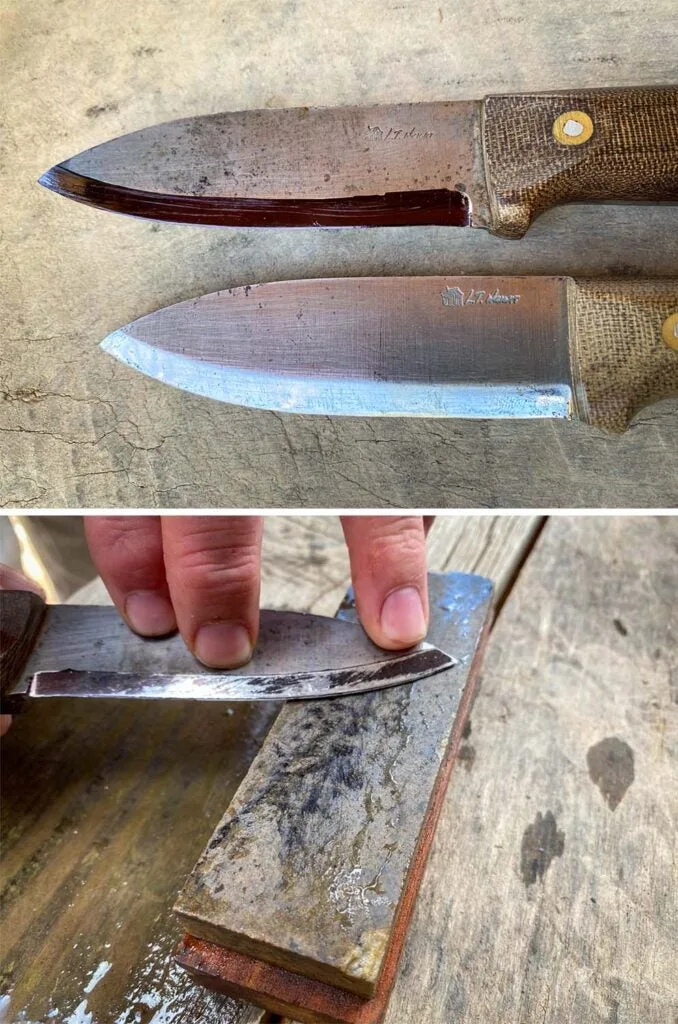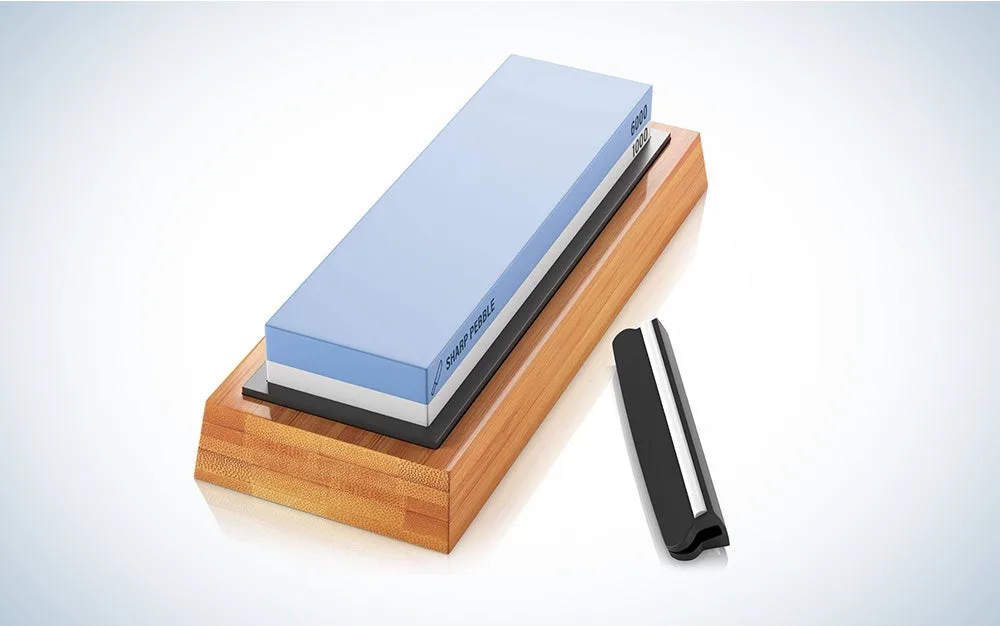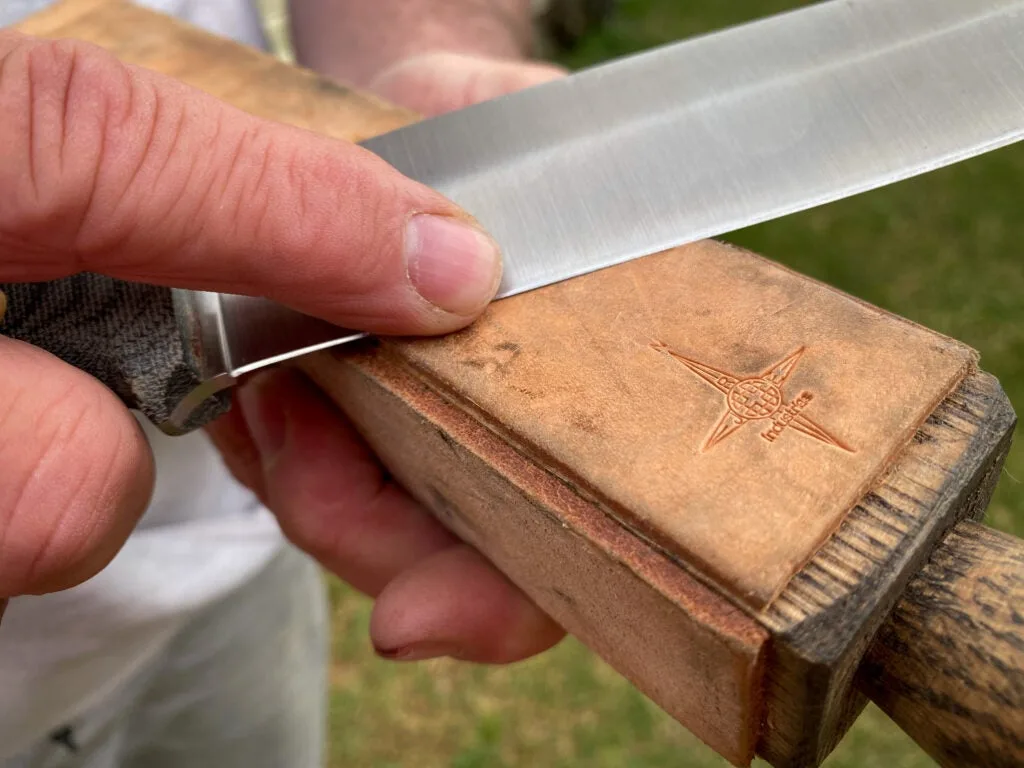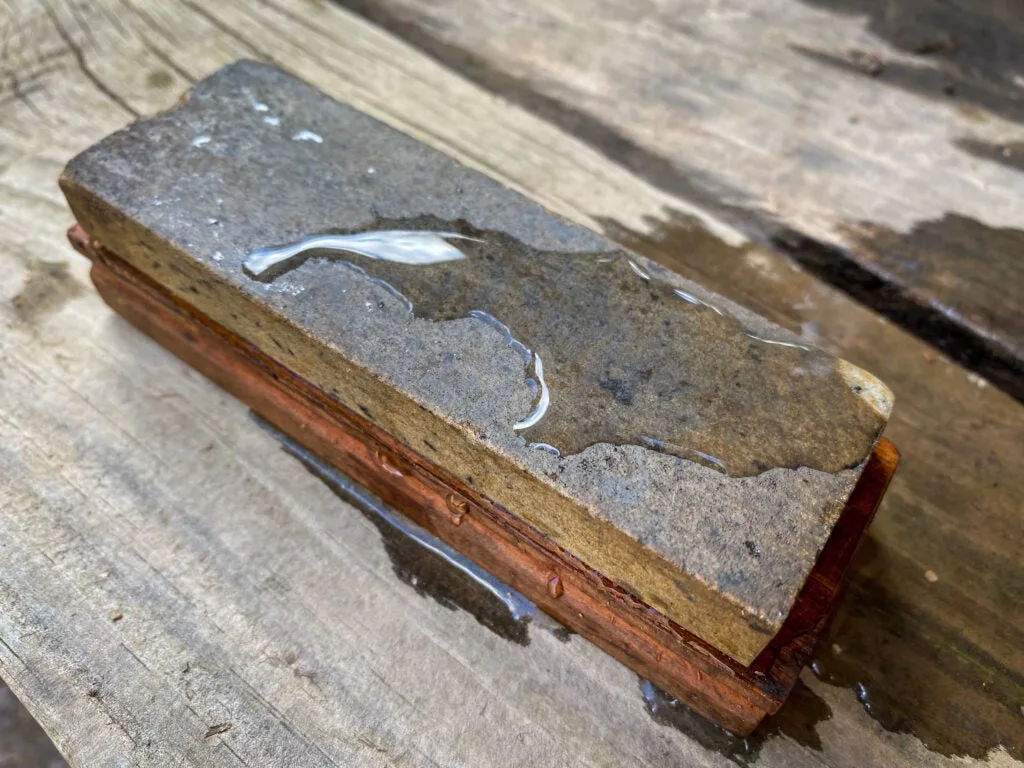We may earn revenue from the products available on this page and participate in affiliate programs. Learn more ›
“A dull knife is a dangerous knife.” If you have never heard that saying before I can confirm its validity for you. It’s true because a dull knife requires you to work harder. When your knife is sharp, it does what it's designed to do without excessive exertion that can cause you to slip. Learning how to sharpen a knife—and knowing how to keep a knife sharp—will lessen your risk of injury and make tasks easier.
As with most skills, there are many different ways to sharpen a knife. This story won’t cover the use of electric sharpeners for knives, for example. Instead, we’ll focus on the more old-school method of using a stone. Follow along here as I share my method on how to sharpen a knife—which is both simple and effective.
How to Sharpen a Knife with a Whetstone
Look closely at the knife’s edge. The grind angle of the knife is how material was removed from the blade to make it sharp enough to cut. You want to work at the same angle in which the blade was made when you’re sharpening it. I use a permanent marker to color the edge, so it is easier to see when I sharpen it. The marker’s residue helps you see how much steel you removed, and helps keep the proper angle. Simply stroke the blade along the whetstone until all the marker is removed.

Pushing vs. Pulling a Knife on a Whetstone
Once you start to sharpen the knife, you can push or pull it. This is one of the most argued aspects of knife sharpening, but it’s a personal preference. Some say to always push the sharp edge away from you. Others will say to pull it toward you. I have done both, and both work well for me. I find it easier to pull it due to some arthritis and previously injured fingers.
The Best Whetstone for Knife Sharpening

The best whetstone for the job is the one your grandfather passed down. But, if you are looking to get a new one, the Sharp Pebble Premium Whetstone is a great knife sharpener. It has 1000 and 6000 grit sides and a great removable base, making it great for initial sharpening and fine-tuning.
advertisement
How to Remove the Burr on a Knife
After sharpening with a stone, you will feel a burr on the edge of the blade. This is a very fine piece of steel along the edge that is curled away from your sharpened edge. To get your knife razor-sharp, you will want to remove that burr, and the best way to do that is to use a leather strop. Use the strop in the same way you use the stone. Don’t skip this step, you will be surprised how much difference the leather makes on the sharpness of your blade.

How to Sharpen a Serrated Knife
Learning how to sharpen a serrated knife can be tricky and it requires you to get a rounded ceramic sharpening stone. Use the round ceramic stone that fits the different rounded edges of the serrations. I have used the Work Sharp Guided Field Sharpener with great success and think it is the best handheld knife sharpener for my needs. An excellent honorable mention on a handheld knife sharpener is the double-sided diamond knife sharpener.
advertisement
How to Sharpen a Knife with a DIY Sharpener
It is also important to know how to sharpen a knife without a sharpener. You should know some tips and tricks to do this for field-expedient sharpening around camp when you may not have all your tools with you. For example, I like to use the edge of a ceramic mug to get the same effect as using a light grit whetstone. Often the baked-on glaze is missing from the bottom of a mug so it has more grip, and it will be rough and unfinished like a terracotta pot. Use that for coursework and the edge when you need some fine-tuning of the blade. Alternatively, you can use the edge of your vehicle’s window to get an excellent, sharpened edge in the field when all your sharpening tools are on the workbench at your house.
Does Your Knife Need Sharpening?
There are two simple ways to tell if a knife is sharp. The most common method is to (at your own risk) bring the ends of your fingers into the blade’s cutting edge and pluck it at a slight angle. If the knife is dull, it will easily slide off. The sharper the knife is, the more it will want to dig into your fingers. Do this slowly, so you don’t cut yourself. Calloused fingers are also helpful if you’re going to use this method. The other way to tell if a knife is sharp is to run it perpendicular to your thumbnail. If the knife is dull, it will glide across it easily and with no friction. If it is sharp, it will start to dig into your nail. Like before, take it slow so you don’t slide the blade off and cut your thumb.
Read Next: The Top Sharpeners for Pocket Knives
advertisement
What to Know Before Sharpening a Knife

The million-dollar question is, “What is the best way to sharpen a knife?” Of course, the best way is the one that works for you. No matter which method you choose, you should know that there are two stages. The first stage in sharpening a knife is grinding. The second is honing.
advertisement
Grinding vs. Honing
Grinding is the practice of removing pieces of steel from your blade. These pieces will easily be seen by the eye. You can do this with a rough whetstone. Sharpening used or abused knives may require additional work, as you may need to use a file to get the nicks off the edge. You can then use a whetstone to sharpen your knife (much more on that in a bit). Honing is the last portion of knife sharpening, where you are realigning the small imperfections of your knife back to the center. Think of it as fine-tuning the blade to get it sharp.
I am a fan of sharpening a knife with a whetstone. Even if I sometimes use the best manual knife sharpener out there, like the Work Sharp, learning how to use a whetstone to sharpen a knife is a must. It teaches you the skill you can then apply with a manual knife sharpener, or in the field when you have no tools at your disposal.
Understanding Different Types of Knife Steel
The knife steel is another topic of importance to understand when learning how to sharpen a knife. Know the type of steel in your blade. Some knives, such as those made by Mora’s, mark the steel type on them, but you can always contact the manufacturer, or consult the internet, about your specific blade. Stainless steel blades are harder, and most find them more challenging to sharpen. Carbon steel is a bit softer and easier to sharpen. Keep in mind it will typically take more strokes on stainless steel than on high carbon steel. Patience is key when learning how to sharpen a knife, regardless of the type of steel. It does not happen quickly. Take your time with either type of steel, and, with patience, you can hone it to a razor's edge.


